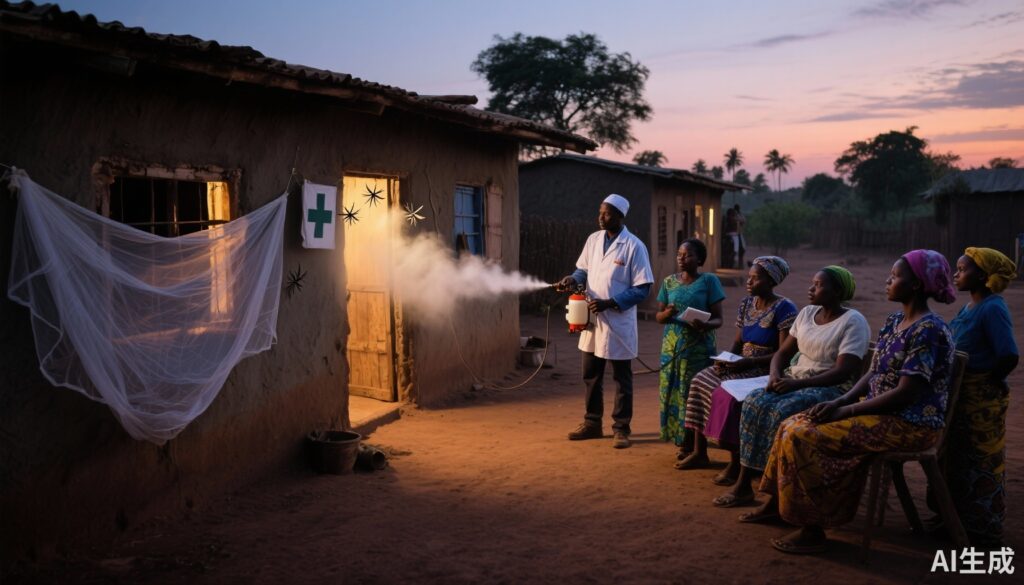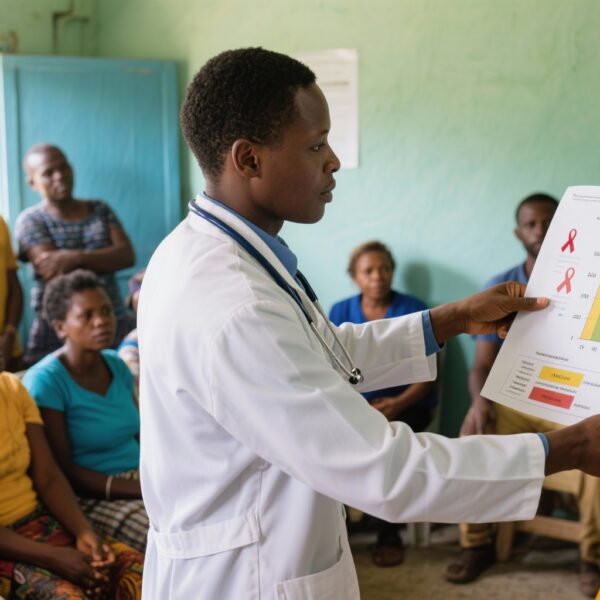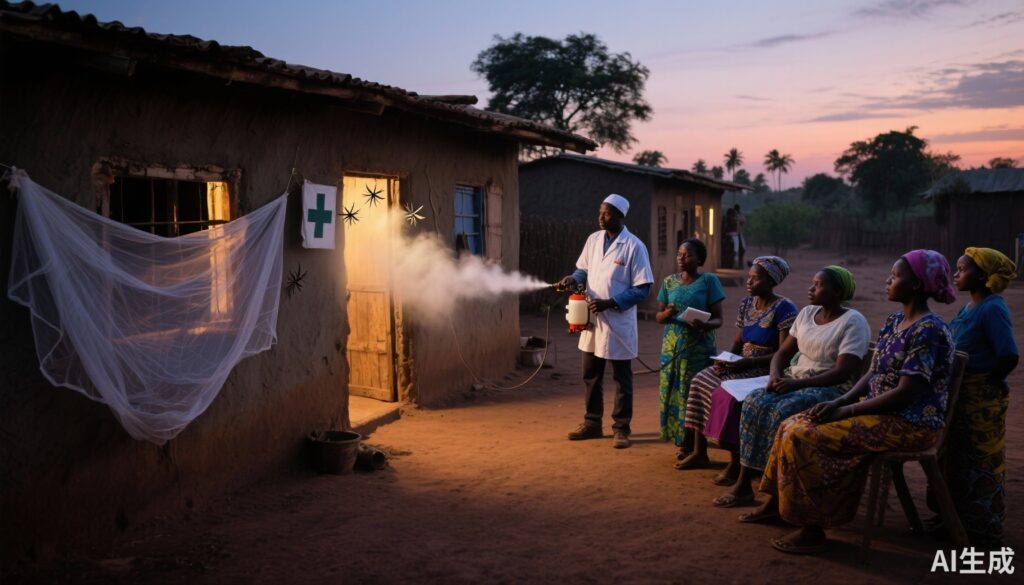Highlight
- Integration of non-pyrethroid indoor residual spraying (IRS) with long-lasting insecticidal nets (LLINs) reduces malaria incidence by 23% compared to LLINs alone in rural West Africa.
- Intensive behaviour change communication (BCC) interventions alongside LLINs achieve a comparable 22% reduction in malaria incidence.
- This cluster-randomised trial provides the first robust evidence on the efficacy of intensive BCC strategies in malaria control.
- Both interventions were well-tolerated with no adverse effects related to IRS, supporting their feasibility in community settings.
Study background and disease burden
Malaria remains a major public health burden in sub-Saharan Africa, accounting for significant morbidity and mortality, especially among children under five and pregnant women. Despite considerable progress between 2000 and 2015, malaria control has plateaued in recent years, largely due to challenges including rising insecticide resistance and stagnating use rates of long-lasting insecticidal nets (LLINs), the cornerstone of vector control. Insecticide resistance, especially to pyrethroids—the only class of insecticides widely used on LLINs—reduces net efficacy, necessitating alternative or complementary control strategies. Indoor residual spraying (IRS) with non-pyrethroid insecticides and behaviour change communication (BCC) aimed at improving net use and other preventive practices represent promising adjuncts to sustain and amplify malaria control gains. This study investigates whether adding non-pyrethroid IRS or intensive BCC to LLIN distribution can further reduce malaria incidence in rural West African communities characterized by high transmission and pyrethroid resistance.
Study design
This pragmatic, parallel-group, cluster-randomised, controlled trial was conducted in 39 villages in Burkina Faso and Côte d’Ivoire, involving approximately 10,750 individuals. Villages were selected based on population size (~300 inhabitants), geographic separation (minimum 2 km between villages), and accessibility. Randomisation allocated villages to three groups: LLIN alone (16 villages, control), LLIN plus non-pyrethroid IRS (11 villages), and LLIN plus intensive BCC (12 villages).
The IRS intervention employed pirimiphos-methyl, a non-pyrethroid insecticide, applied to internal walls of dwellings, aiming to kill mosquitoes resting indoors. The BCC intervention entailed trained teams delivering home visits, interpersonal discussions, and group talks promoting consistent LLIN use, environmental sanitation, and prompt health-seeking behavior.
Data collectors and laboratory personnel were blinded to group allocation but it was not feasible to mask participants or field teams implementing interventions. Malaria incidence rate, the primary endpoint, was measured by passive case detection over a 10-month period before and after intervention implementation, capturing symptomatic malaria cases presenting at health centers.
Data analysis was intention-to-treat and utilized constrained baseline approaches to account for pre-intervention malaria incidence differences. The trial was registered with ClinicalTrials.gov (NCT03074435).
Key findings
Between November 2016 and August 2018, the study accrued 215,000 person-months of follow-up and recorded 3,612 malaria cases through passive detection. Comparing post-intervention outcomes with pre-intervention baseline and between groups revealed:
– A 23% reduction in malaria incidence rate among LLIN plus IRS villages relative to LLIN alone (rate ratio [RR] 0.77; 95% confidence interval [CI] 0.64 to 0.93; p=0.0073).
– A 22% reduction in incidence rate in LLIN plus BCC villages compared to LLIN only (RR 0.78; 95% CI 0.63 to 0.96; p=0.020).
Both interventions thus achieved statistically significant, clinically meaningful decreases in malaria burden.
No adverse effects attributable to IRS were observed, underscoring safety of the pirimiphos-methyl formulation used. The IRS effect size was intermediate relative to prior African trials, potentially attributable to local factors such as existing vector resistance profiles, housing conditions, and coverage fidelity.
The intensive BCC intervention demonstrated its first trial-based efficacy evidence, supporting its potential as a scalable and cost-effective complement to LLINs. The multi-pronged communication approach targeting behaviours beyond net use may contribute to broader community engagement in malaria prevention.
Expert commentary
The findings hold important implications for malaria control programs facing pyrethroid resistance and stagnating net use. While LLINs remain vital, reliance on a single intervention risks programmatic stagnation. This study supports deployment of combination interventions utilizing multiple vector control mechanisms and behaviour modification.
Non-pyrethroid IRS using pirimiphos-methyl circumvents pyrethroid resistance and can interrupt transmission by reducing indoor mosquito populations. However, challenges include cost, logistics, and insecticide resistance management. The intermediate IRS effect here suggests context-specific adaptation may be required.
Behaviour change communication efforts detailed here extend beyond mere net distribution to include structured interpersonal and group interventions, showing promising impact on malaria outcomes. Nonetheless, the durability of these behavioural gains post-intervention and scalability in diverse settings warrant further evaluation.
Limitations of the trial include lack of blinding among deliverers and participants, which may introduce bias. Passive case detection might underestimate true incidence, and environmental or seasonal factors were not exhaustively controlled. Nevertheless, the pragmatism enhances external validity.
These results align with the growing consensus that integrated vector management combining chemical and behavioural interventions is essential to advance malaria control.
Conclusion
This robust cluster-randomised trial from West Africa demonstrates that supplementing long-lasting insecticidal nets with either non-pyrethroid indoor residual spraying or intensive behaviour change communication significantly reduces malaria incidence by approximately 22 to 23 percent. The data underscore the need for diversified malaria control strategies amid challenges of insecticide resistance and limited net adherence. Crucially, this study provides the first trial-supported evidence for intensive behaviour change communication as an effective malaria control tool.
For policy and practice, these findings advocate for integrating tailored IRS approaches and sustained community engagement through BCC interventions within LLIN distribution programs to optimize malaria prevention impact. Continued research should focus on confirming these results in varied epidemiological contexts, assessing cost-effectiveness, and exploring long-term impacts on malaria transmission dynamics.
References
1. Moiroux N, Zongo I, Assi SB, et al. Efficacy of non-pyrethroid indoor residual spraying or intensive behaviour change communication in combination with long-lasting insecticidal nets for malaria control in west Africa: a pragmatic, cluster-randomised, controlled trial. Lancet Glob Health. 2025 Sep;13(9):e1605-e1616. doi:10.1016/S2214-109X(25)00216-5. PMID: 40845886.
2. World Health Organization. Global Malaria Programme. World Malaria Report 2023. Geneva: WHO; 2023.
3. Ranson H, Lissenden N. Insecticide resistance in African Anopheles mosquitoes: A worsening situation that needs urgent action to maintain malaria control. Trends Parasitol. 2016;32(3):187-196. doi:10.1016/j.pt.2015.11.010.
4. Killeen GF. Characterizing, controlling and eliminating residual malaria transmission. Malar J. 2014;13:330. doi:10.1186/1475-2875-13-330.
5. Eisele TP, Larsen D, Steketee RW. Protective efficacy of interventions for preventing malaria mortality in children in Plasmodium falciparum endemic areas. Int J Epidemiol. 2010;39 Suppl 1:i88-101. doi:10.1093/ije/dyq031.




